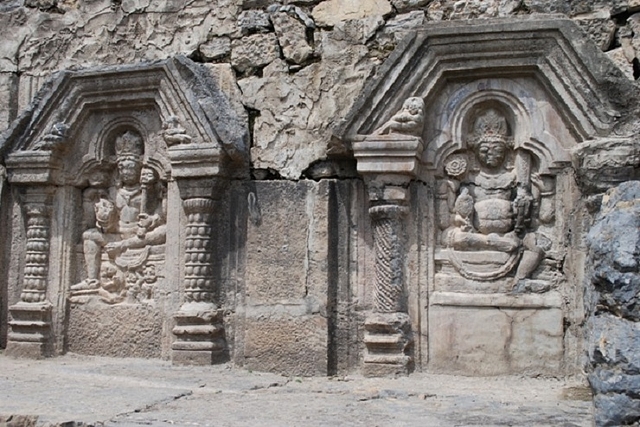
Kashmir Can Become One Of The Great Centres Of World Art Through The Restoration Of Its Temples
The art and architecture of Kashmir presents a side to the Indian artistic imagination that is unique in the value given to proportion and structural coherence.
I am writing this column to make the case that we need not only look at science and technology as means of economic and social development. Culture is a resource that develops human potential and prepares a person for success in all endeavours. Furthermore, cultural tourism will become increasingly important in the coming decades as economies adjust to automation and robotics.
In spite of amazing monuments, mausoleums and forts, India is not doing so well in marketing its cultural treasures and attracting foreign travellers. There are campaigns to promote religious tourism but that might be looking too narrowly at the potential that exists.
Each year India gets about 7.7 million international visitors (many of whom are Indians settled abroad) whereas China gets almost 60 million. Even Vietnam, a country with less than 1/12th of India’s population gets more. Other comparisons: France has 84 million visitors and Thailand 25 million.
Now for a specific comparison, let me consider Indonesia, whose population is one-fifth that of India, but which gets more tourists. It is tapping in to the demand for viewing great ancient architecture. Its ninth century Borobudur and Prambanan temples are included in the list of the world’s greatest wonders and they are perhaps the main attraction for foreign tourists to visit it, outside of Bali. What people don’t know is that these sites were in ruins a century ago.
The reconstruction of these temples took decades of painstaking work. The pictures of Prambanan from a century ago and now are shown below.
When people wish to visit any great old temple, they go to Indonesia and Cambodia (for Angkor Wat). While they are there, they also buy modern art objects like paintings and sculpture which helps the economy in multiple ways.
India will do well to replicate the Indonesian model. I will consider this for a forgotten masterpiece of world architecture in Kashmir, and such restoration can be carried out elsewhere as well.
The ancient temple ruins in Kashmir are remarkable for their order and balance and they are older than Prambanan and Borobudur by one or two centuries. According to the 16th century Tibetan scholar Lama Tārānāth, author of History of Buddhism in India, there existed in India four principal school of art: eastern, middle country, Marwar, and the Kashmiri. The art and architecture of Kashmir presents a side to the Indian artistic imagination that is unique in the value given to proportion and structural coherence.
I speak here only of the Mārtanḍa Temple on the Mattan Karewa, built by Emperor Lalitāditya (r. 724-270) who is generally remembered for his military campaigns and expanding his empire from Kannauj to Turkestan. In his time some remarkable innovations took place in art and architecture as well.
Lalitāditya built an enormous chaitya in the town of Parihāsapura which housed an enormous Buddha. Only the plinth of this huge monument survives, although it is represented in one of the paintings at Alchi in Ladakh. There was also an enormous stupa in Parihāsapura built by Lalitāditya’s minister Chankuna, which may have even been larger than the chaitya. It is believed that the Parihāsapura monuments served as models for Buddhist architecture from Afghanistan to Japan.
The Mārtanḍa temple is one of the most beautiful temples ever designed. Built of stone, it is characterised by the simplicity of its design, a hallmark of Kashmirian art and architecture. The temple is rectangular in plan, consisting of a maṇḍapa and a shrine. Two other shrines flank the maṇḍapa. It is enclosed by a vast courtyard by a peristyle wall with 84 secondary shrines in it. The columns of the peristyle are fluted. Each of the 84 niches originally contained an image of a form of Sūrya. The number 84, as 21×4, appears to have been derived from the numerical association of 21 with the sun. Below is also the restored impression of the temple from Letters from India and Kashmir by J. Duguid, 1870-73.
As the reconstruction shows, it must have looked like a jeweled treasure on the plateau over Anantnag. It can hold its own against great architectural treasures like Prambanan and Borobudur by the sheer beauty of its conception. For people who are interested in the Indian antecedents of the Indonesian masterpieces, the Mārtanḍa Temple is an invaluable link.
The Mārtanḍa Temple connects us to the great 9th century complex of Avantipura built by King Avantivarman (r. 855-883) which is an amalgam of various earlier prevalent forms of India and regions beyond. It also helps understand the evolution of the form in the bronzes dated to 9th to 11th century modelled by Kashmiri craftsmen for Tibetan patrons.
The style of such bronzes presents a remarkable affinity to the wall-paintings dating to 10-11th century decorated in the Buddhist temples of Western Tibet. The Tibetan scholar Rinchen Sangpo (950 – 1055) claimed to have visited Kashmir thrice to obtain the services of 75 Kashmiri craftsmen, painters and teachers to build and decorate one hundred and eight temples in Western Tibet.
Perhaps the restoration of the Mārtanḍa Temple will help Kashmir regain its place as one of the great centres of world art.
References: